Evaluation of Agricultural BMPs’ Impact on Water Quality and Crop Production Using SWAT+ Model
Abstract
1. Introduction
2. Materials and Methods
2.1. Study Area Description and Study Flow
2.2. SWAT+ Model Description
2.3. SWAT+ Model Input Data
2.4. SWAT+ Model Calibration and Validation
2.5. SWAT+ Model Long-Term Simulation Scenarios
3. Results and Discussion
3.1. Hydrologic Calibration and Validation
3.2. Nitrate and Crop Yield Calibration and Validation
3.3. Effects of the Combined BMPs on Water Quality and Crop Yield
4. Limitations of This Study
5. Conclusions
Supplementary Materials
Author Contributions
Funding
Data Availability Statement
Conflicts of Interest
References
- Breitburg, D.; Levin, L.A.; Oschlies, A.; Grégoire, M.; Chavez, F.P.; Conley, D.J.; Garçon, V.; Gilbert, D.; Gutiérrez, D.; Isensee, K.; et al. Declining oxygen in the global ocean and coastal waters. Science 2018, 359, eaam7240. [Google Scholar] [CrossRef]
- Follett, R.F. (Ed.) Nitrogen Management and Ground Water Protection; Elsevier: Amsterdam, The Netherlands, 2012. [Google Scholar]
- Lal, R. Soils and sustainable agriculture. A review. Agron. Sustain. Dev. 2008, 28, 57–64. [Google Scholar] [CrossRef]
- Donner, S.D.; Kucharik, C.J. Evaluating the impacts of land management and climate variability on crop production and nitrate export across the Upper Mississippi Basin. Glob. Biogeochem. Cycles 2003, 17, 1–18. [Google Scholar] [CrossRef]
- Robertson, D.M.; Saad, D.A. SPARROW Models Used to Understand Nutrient Sources in the Mississippi/Atchafalaya River Basin. J. Environ. Qual. 2013, 42, 1422–1440. [Google Scholar] [CrossRef]
- Porter, P.A.; Mitchell, R.B.; Moore, K.J. Reducing hypoxia in the Gulf of Mexico: Reimagining a more resilient agricultural landscape in the Mississippi River Watershed. J. Soil. Water Conserv. 2015, 70, 63A–68A. [Google Scholar] [CrossRef]
- Alexander, R.B.; Smith, R.A.; Schwarz, G.E.; Boyer, E.W.; Nolan, J.V.; Brakebill, J.W. Differences in phosphorus and nitrogen delivery to the Gulf of Mexico from the Mississippi River Basin. Environ. Sci. Technol. 2008, 42, 822–830. [Google Scholar] [CrossRef] [PubMed]
- IEPA. Illinois Department of Agriculture, 2015, Illinois Nutrient Loss Reduction Strategy; Illinois Environmental Protection Agency: Springfield, IL, USA, 2015. [Google Scholar]
- Strock, J.S.; Porter, P.M.; Russelle, M.P. Cover Cropping to Reduce Nitrate Loss through Subsurface Drainage in the Northern U.S. Corn Belt. J. Environ. Qual. 2004, 33, 1010. [Google Scholar] [CrossRef] [PubMed]
- Kaspar, T.C.; Jaynes, D.B.; Parkin, T.B.; Moorman, T.B. Rye Cover Crop and Gamagrass Strip Effects on NO 3 Concentration and Load in Tile Drainage. J. Environ. Qual. 2007, 36, 1503–1511. [Google Scholar] [CrossRef]
- King, K.; Williams, M.; LaBarge, G.; Smith, D.; Reutter, J.; Duncan, E.; Pease, L. Addressing agricultural phosphorus loss in artificially drained landscapes with 4R nutrient management practices. J. Soil. Water Conserv. 2018, 73, 35–47. [Google Scholar] [CrossRef]
- Daryanto, S.; Fu, B.; Wang, L.; Jacinthe, P.A.; Zhao, W. Quantitative synthesis on the ecosystem services of cover crops. Earth Sci. Rev. 2018, 185, 357–373. [Google Scholar] [CrossRef]
- Thorp, K.R.; Malone, R.W.; Jaynes, D.B. Simulating long-term effects of nitrogen fertilizer application rates on corn yield and nitrogen dynamics. Trans. ASABE 2007, 50, 1287–1303. [Google Scholar] [CrossRef]
- Fang, Q.X.; Malone, R.W.; Ma, L.; Jaynes, D.B.; Thorp, K.R.; Green, T.R.; Ahuja, L.R. Modeling the effects of controlled drainage, N rate and weather on nitrate loss to subsurface drainage. Agric. Water Manag. 2012, 103, 150–161. [Google Scholar] [CrossRef]
- Jeong, H.; Bhattarai, R. Exploring the effects of nitrogen fertilization management alternatives on nitrate loss and crop yields in tile-drained fields in Illinois. J. Environ. Manag. 2018, 213, 341–352. [Google Scholar] [CrossRef] [PubMed]
- Singh, S.; Bhattarai, R.; Negm, L.M.; Youssef, M.A.; Pittelkow, C.M. Evaluation of nitrogen loss reduction strategies using DRAINMOD-DSSAT in east-central Illinois. Agric. Water Manag. 2020, 240, 106322. [Google Scholar] [CrossRef]
- Gowda, P.H.; Mulla, D.J.; Jaynes, D.B. Simulated long-term nitrogen losses for a midwestern agricultural watershed in the United States. Agric. Water Manag. 2008, 95, 616–624. [Google Scholar] [CrossRef]
- Jaynes, D.B.; Dinnes, D.L.; Meek, D.W.; Karlen, D.L.; Cambardella, C.A.; Colvin, T.S. Using the Late Spring Nitrate Test to Reduce Nitrate Loss within a Watershed. J. Environ. Qual. 2004, 33, 669–677. [Google Scholar] [CrossRef]
- Kaspar, T.C.; Jaynes, D.B.; Parkin, T.B.; Moorman, T.B.; Singer, J.W. Effectiveness of oat and rye cover crops in reducing nitrate losses in drainage water. Agric. Water Manag. 2012, 110, 25–33. [Google Scholar] [CrossRef]
- Krueger, E.S.; Ochsner, T.E.; Baker, J.M.; Porter, P.M.; Reicosky, D.C. Rye-corn silage double-cropping reduces corn yield but improves environmental impacts. Agron. J. 2012, 104, 888–896. [Google Scholar] [CrossRef]
- Blanco-Canqui, H. Cover crops and water quality. Agron. J. 2018, 110, 1633–1647. [Google Scholar] [CrossRef]
- Hanrahan, B.R.; Tank, J.L.; Christopher, S.F.; Mahl, U.H.; Trentman, M.T.; Royer, T.V. Winter cover crops reduce nitrate loss in an agricultural watershed in the central U.S. Agric. Ecosyst. Environ. 2018, 265, 513–523. [Google Scholar] [CrossRef]
- Dinnes, D.L.; Karlen, D.L.; Jaynes, D.B.; Kaspar, T.C.; Hatfield, J.L.; Colvin, T.S.; Cambardella, C.A. Nitrogen Management Strategies to Reduce Nitrate Leaching in Tile-Drained Midwestern Soils. Agron. J. 2002, 94, 153–171. [Google Scholar] [CrossRef]
- Staver, K.W.; Brinsfield, R.B. Using Cereal Grain Winter Cover Crops to Reduce Groundwater Nitrate Contamination in the Mid Atlantic Coastal Plain; SWCS: Hong Kong, China, 1998. [Google Scholar]
- Qi, Z.; Helmers, M.J. Soil Water Dynamics under Winter Rye Cover Crop in Central Iowa. Vadose Zone J. 2010, 9, 53. [Google Scholar] [CrossRef]
- Li, L.; Malone, R.W.; Ma, L.; Kaspar, T.C.; Jaynes, D.B.; Saseendran, S.A.; Thorp, K.R.; Yu, Q.; Ahuja, L.R. Winter Cover Crop Effects on Nitrate Leaching in Subsurface Drainage as Simulated by RZWQM-DSSAT. Trans. ASABE 2008, 51, 1575–1583. [Google Scholar] [CrossRef]
- Drury, C.F.; Tan, C.S.; Welacky, T.W.; Reynolds, W.D.; Zhang, T.Q.; Oloya, T.O.; McLaughlin, N.B.; Gaynor, J.D. Reducing Nitrate Loss in Tile Drainage Water with Cover Crops and Water-Table Management Systems. J. Environ. Qual. 2014, 43, 587–598. [Google Scholar] [CrossRef] [PubMed]
- Martinez-Feria, R.A.; Dietzel, R.; Liebman, M.; Helmers, M.J.; Archontoulis, S.V. Rye cover crop effects on maize: A system-level analysis. Field Crop. Res. 2016, 196, 145–159. [Google Scholar] [CrossRef]
- Parajuli, P.B.; Nelson, N.O.; Frees, L.D.; Mankin, K.R. Comparison of AnnAGNPS and SWAT model simulation results in USDA-CEAP agricultural watersheds in south-central Kansas. Hydrol. Process. 2009, 23, 748–763. [Google Scholar]
- Lee, S.; Yeo, I.-Y.; Sadeghi, A.M.; McCarty, G.W.; Hively, W.D.; Lang, M.W. Impacts of Watershed Characteristics and Crop Rotations on Winter Cover Crop Nitrateitrogen Uptake Capacity within Agricultural Watersheds in the Chesapeake Bay Region. PLoS ONE 2016, 11, e0157637. [Google Scholar] [CrossRef]
- Venishetty, V.; Parajuli, P.B. Assessment of BMPs by Estimating Hydrologic and Water Quality Outputs Using SWAT in Yazoo River Watershed. Agriculture 2022, 12, 477. [Google Scholar] [CrossRef]
- SWAT Homepage. SWAT Documentation. Available online: https://swat.tamu.edu/docs/ (accessed on 8 July 2023).
- MRCC. Annual Precipitation Data Summary; Midwestern Regional Climate Center: West Lafayette, IN, USA, 2020. [Google Scholar]
- Arnold, J.G.; Srinivasan, R.; Muttiah, R.S.; Williams, J.R. Large area hydrologic modeling and assessment part I: Model development. J. Am. Water Resour. Assoc. 1998, 34, 73–89. [Google Scholar] [CrossRef]
- Arnold, J.G.; Moriasi, D.N.; Gassman, P.W.; Abbaspour, K.C.; White, M.J.; Srinivasan, R.; Santhi, C.; Harmel, R.D.; Van Griensven, A.; Van Liew, M.W.; et al. SWAT: Model use, calibration, and validation. Trans. ASABE 2012, 55, 1491–1508. [Google Scholar] [CrossRef]
- Gassman, P.W.; Reyes, M.R.; Green, C.H.; Arnold, J.G.; Gassman, P.W. The soil and water assessment tool: Historical development, applications, and future research directions. Trans. ASABE 2007, 50, 1211–1250. [Google Scholar] [CrossRef]
- Gassman, P.W.; Sadeghi, A.M.; Srinivasan, R. Applications of the SWAT Model Special Section: Overview and Insights. J. Environ. Qual. 2014, 43, 1–8. [Google Scholar] [CrossRef]
- Bieger, K.; Arnold, J.G.; Rathjens, H.; White, M.J.; Bosch, D.D.; Allen, P.M.; Volk, M.; Srinivasan, R. Introduction to SWAT+, A Completely Restructured Version of the Soil and Water Assessment Tool. J. Am. Water Resour. Assoc. 2017, 53, 115–130. [Google Scholar] [CrossRef]
- USDA NASS (United States Department of Agriculture National Agricultural Statistics Service). Available online: https://www.nass.usda.gov/ (accessed on 8 July 2023).
- Abatzoglou, J.T. Development of gridded surface meteorological data for ecological applications and modelling. Int. J. Climatol. 2013, 33, 121–131. [Google Scholar] [CrossRef]
- Sobol, I.M. Sensitivity analysis for non-linear mathematical models. Math. Modeling Comput. Experiment. 1993, 1, 407–414. [Google Scholar]
- Schürz, C. Development of Tools and Interfaces for the Implementation, Pre-Processing, and Sensitivity Analysis of the SWAT Model in an R Programming Environment; Austrian Marshall Plan Foundation: Vienna, Austria, 2019. [Google Scholar]
- Moriasi, D.N.; Arnold, J.G.; Van Liew, M.W.; Bingner, R.L.; Harmel, R.D.; Veith, T.L. Model Evaluation Guidelines for Systematic Quantification of Accuracy in Watershed Simulations. Trans. ASABE 2007, 50, 885–900. [Google Scholar] [CrossRef]
- Moriasi, D.N.; Gitau, M.W.; Pai, N.; Daggupati, P. Hydrologic and water quality models: Performance measures and evaluation criteria. Trans. ASABE 2015, 58, 1763–1785. [Google Scholar] [CrossRef]
- Nash, J.E.; Sutcliffe, J.V. River flow forecasting through conceptual models part I—A discussion of principles. J. Hydrol. 1970, 10, 282–290. [Google Scholar] [CrossRef]
- Liu, H.L.; Yang, J.Y.; Tan, C.S.; Drury, C.F.; Reynolds, W.D.; Zhang, T.Q.; Bai, Y.L.; Jin, J.; He, P.; Hoogenboom, G. Simulating water content, crop yield and nitrate loss under free and controlled tile drainage with subsurface irrigation using the DSSAT model. Agric. Water Manag. 2011, 98, 1105–1111. [Google Scholar] [CrossRef]
- Jamieson, P.D.; Porter, J.R.; Wilson, D.R. A test of the computer simulation model ARCWHEAT1 on wheat crops grown in New Zealand. Field Crops Res. 1991, 27, 337–350. [Google Scholar] [CrossRef]
- Hargreaves, G.H.; Allen, R.G. History and evaluation of Hargreaves evapotranspiration equation. J. Irrig. Drain. Eng. 2003, 129, 53–63. [Google Scholar] [CrossRef]
- Sanford, W.E.; Selnick, D.L. Erratum to Estimation of Evapotranspiration across the Conterminous United States Using a Regression with Climate and Land-Cover Data. J. Am. Water Resour. Assoc. 2013, 49, 479. [Google Scholar] [CrossRef]
- Moriasi, D.N.; Gowda, P.H.; Arnold, J.G.; Mulla, D.J.; Ale, S.; Steiner, J.L. Modeling the impact of nitrogen fertilizer application and tile drain configuration on nitrate leaching using SWAT. Agric. Water Manag. 2013, 130, 36–43. [Google Scholar] [CrossRef]
- Bakhsh, A.; Kanwar, R.S.; Jaynes, D.B.; Colvin, T.S.; Ahuja, L.R. Simulating effects of variable nitrogen application rates on corn yields and NO3–N losses in subsurface drain water. Trans. ASAE 2001, 44, 269. [Google Scholar] [CrossRef]
- Rosa, A.T.; Creech, C.F.; Elmore, R.W.; Rudnick, D.R.; Lindquist, J.L.; Fudolig, M.; Butts, L.; Werle, R. Implications of cover crop planting and termination timing on rainfed maize production in semi-arid cropping systems. Field Crops Res. 2021, 271, 108251. [Google Scholar] [CrossRef]
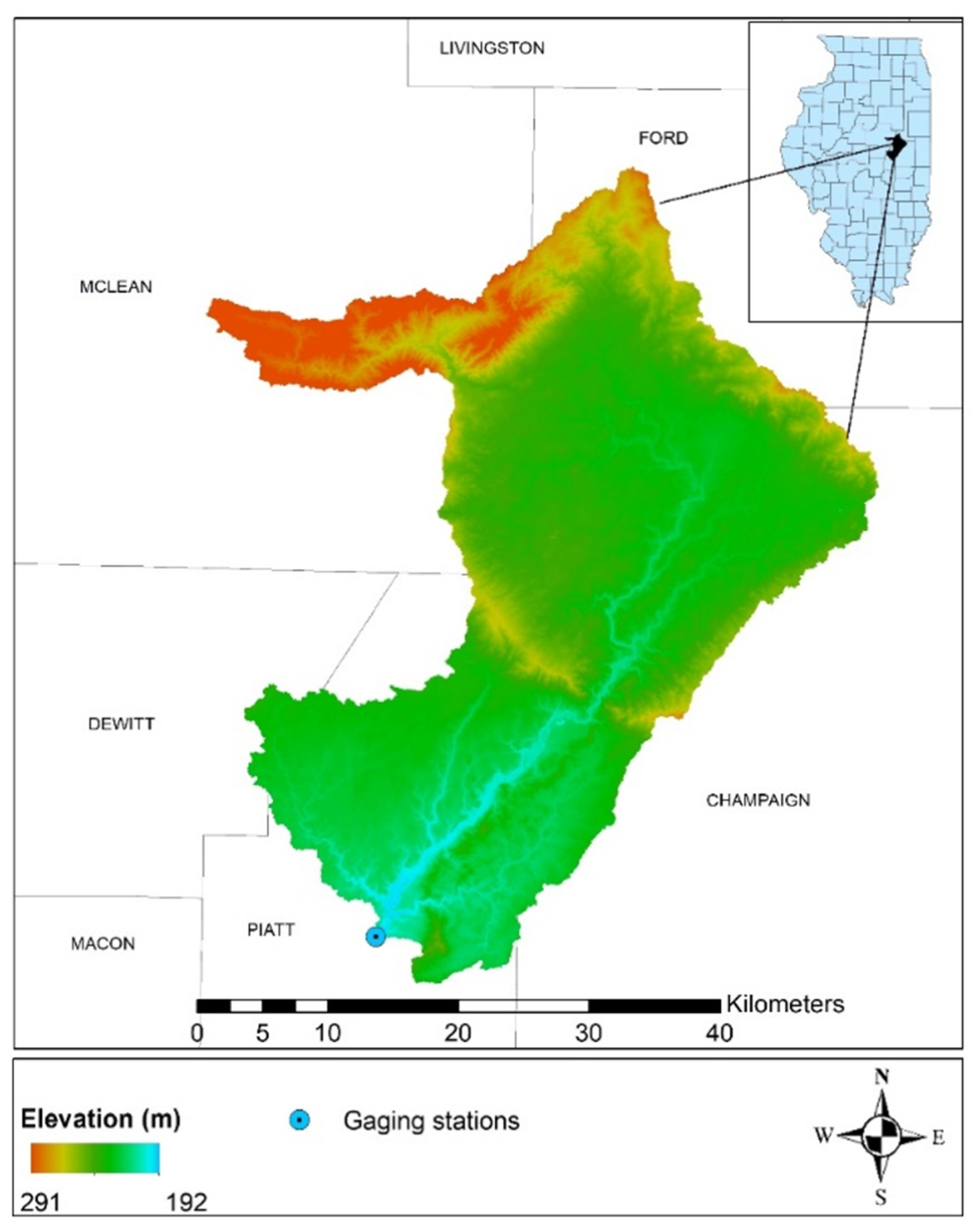

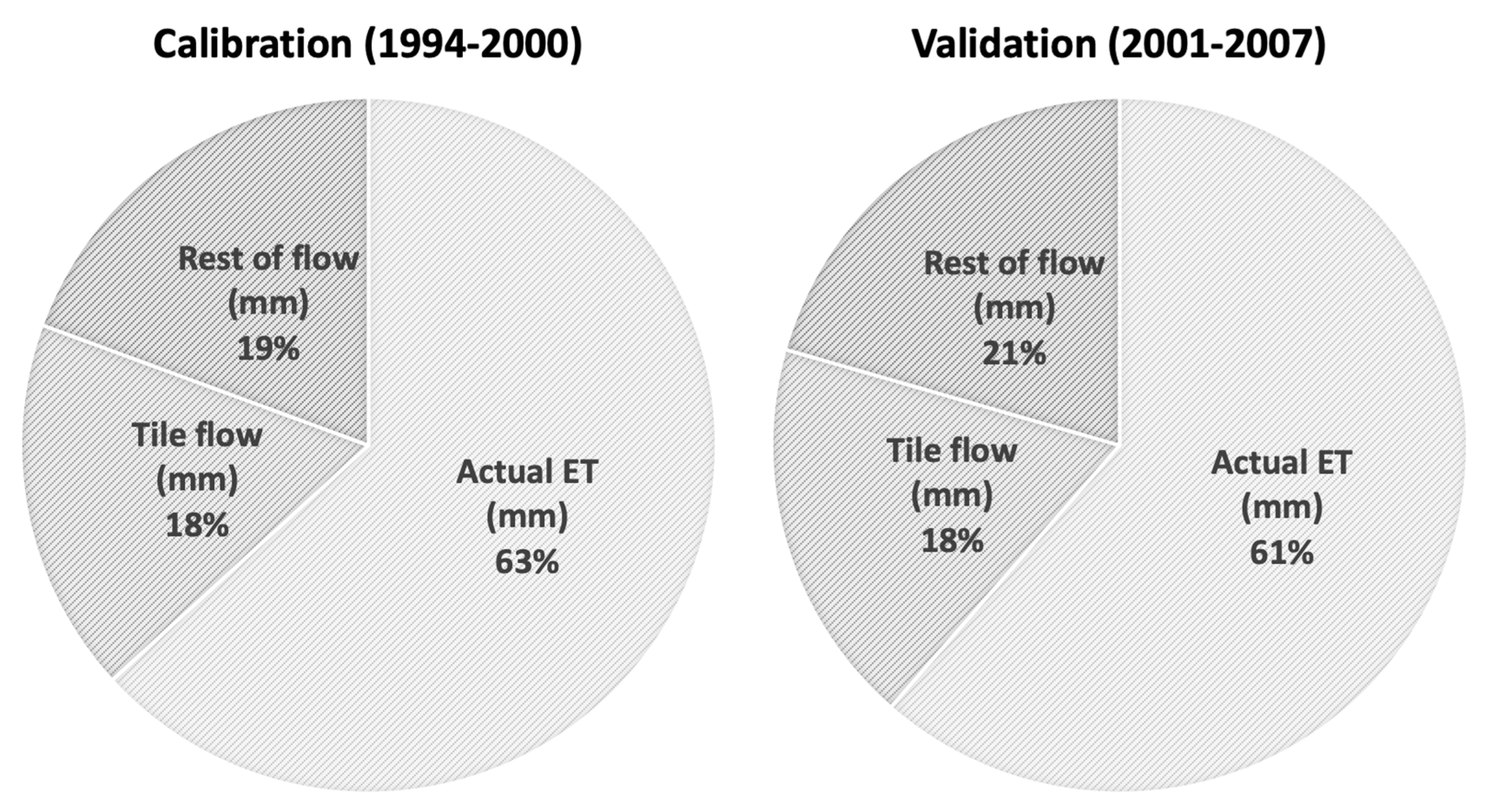
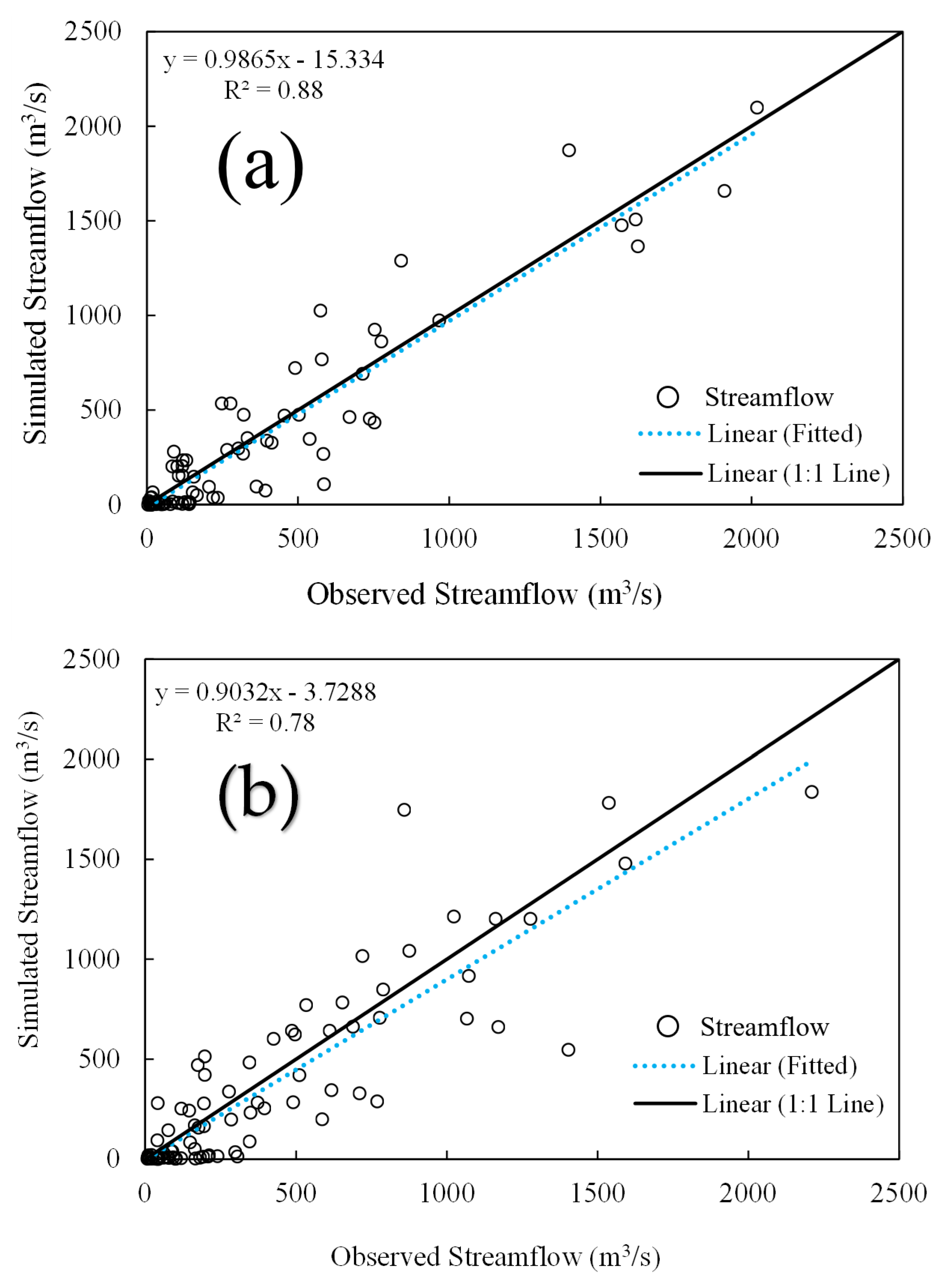
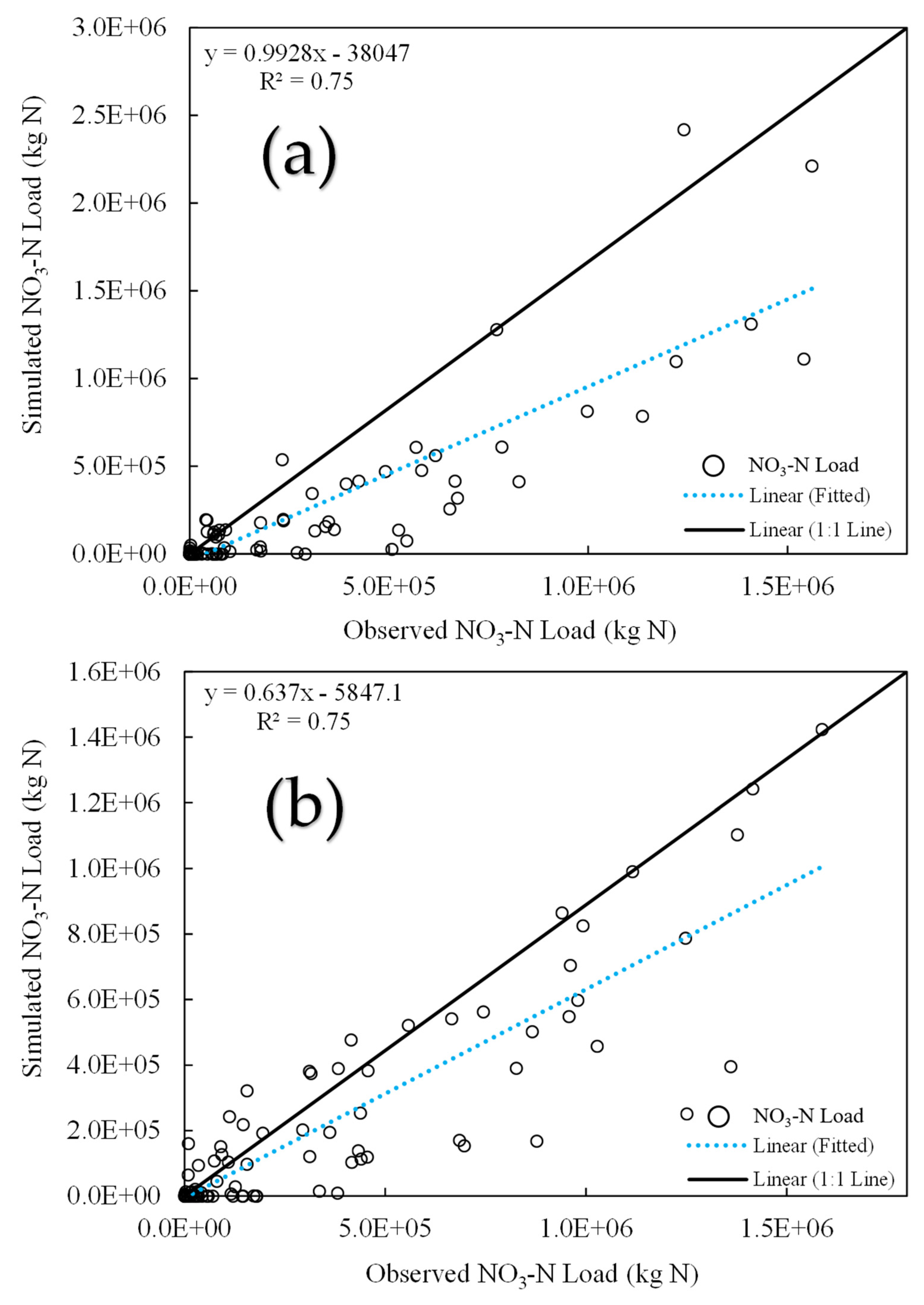
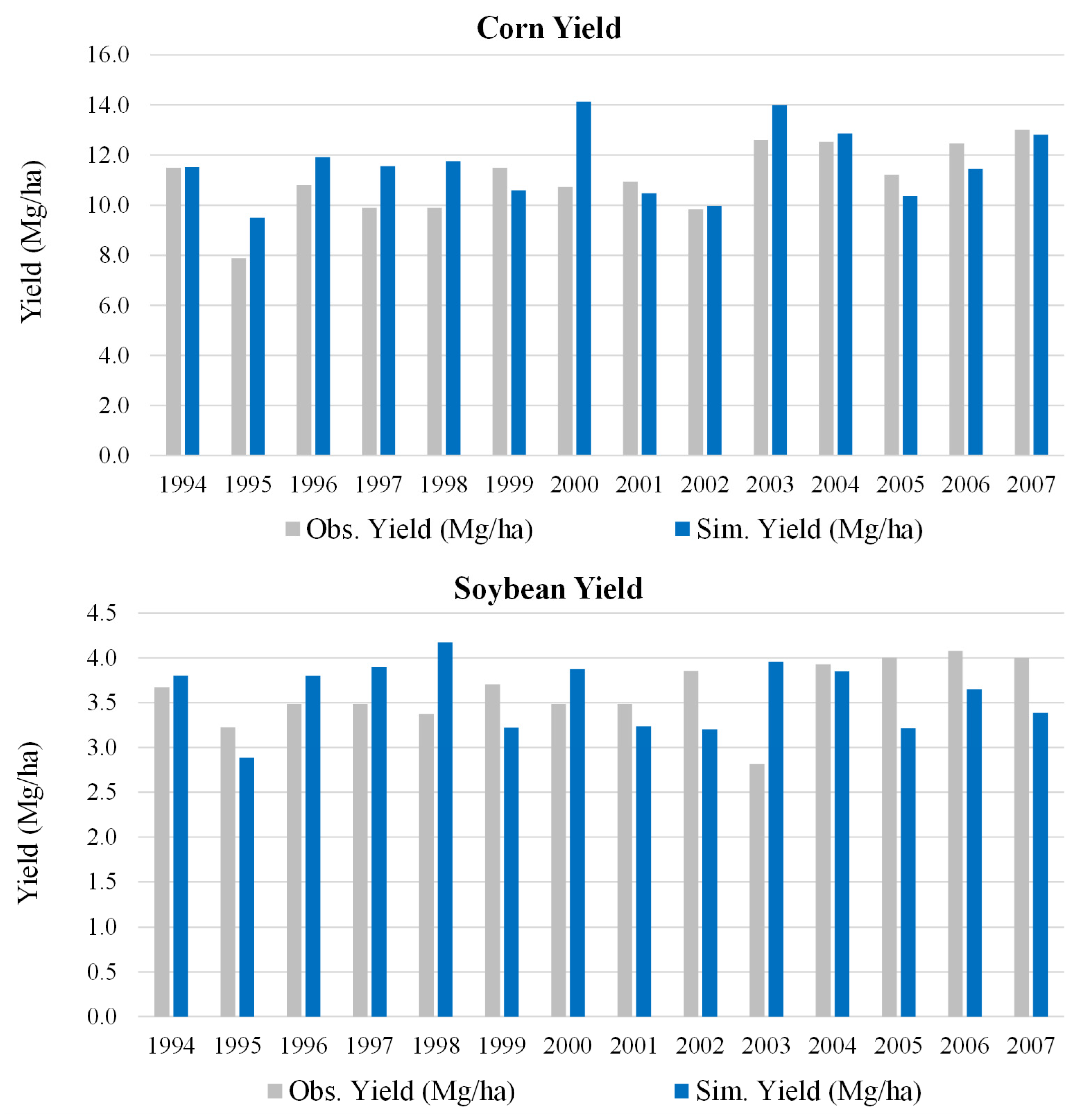
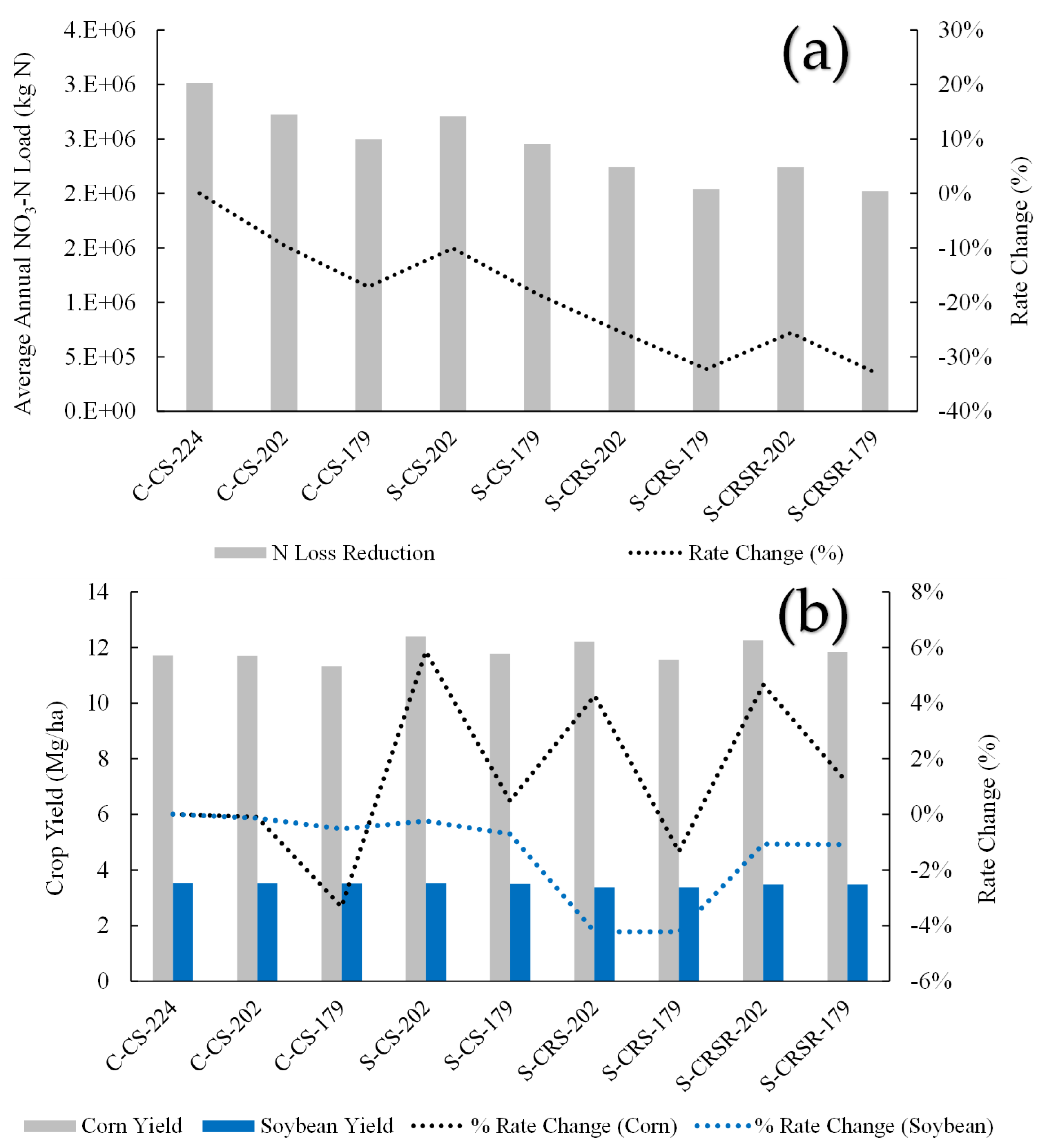
| Methods | Scenario | N Application Rates | Crop Rotation | Description |
|---|---|---|---|---|
| Conventional | C-CS | 224, 202, 179 | Corn–soybean | 100% spring pre-plant N application |
| 40:60 split N application | S-CS | 202, 179 | Corn–soybean | 40% spring pre-plant application and 60% as side-dressing |
| 40:60 split N application | S-CRS | 202, 179 | Corn–rye–soybean | |
| 40:60 split N application | S-CRSR | 202, 179 | Corn–rye–soybean–rye |
| Components | Monthly Statistics | |||
|---|---|---|---|---|
| Calibration Period (1994–2000) | NSE | R-Square | PBIAS (%) | n-RMSE (%) |
| Streamflow | 0.87 | 0.88 | −5.9 | - |
| Validation Period (2001–2007) | NSE | R-Square | PBIAS (%) | n-RMSE (%) |
| Streamflow | 0.75 | 0.78 | −10.6 | - |
| Components | Monthly Statistics | |||
|---|---|---|---|---|
| Calibration Period (1994–2000) | NSE | R-Square | PBIAS (%) | n-RMSE (%) |
| Nitrate Load | 0.66 | 0.75 | −14.5 | - |
| Crop Yield | ||||
| Corn | - | - | 12 | 16 |
| Soybean | - | - | 5 | 13 |
| Validation Period (2001–2007) | NSE | R-Square | PBIAS (%) | n-RMSE (%) |
| Nitrate Load | 0.63 | 0.75 | −37.9 | - |
| Crop Yield | ||||
| Corn | - | - | −1 | 7 |
| Soybean | - | - | −6 | 19 |
Disclaimer/Publisher’s Note: The statements, opinions and data contained in all publications are solely those of the individual author(s) and contributor(s) and not of MDPI and/or the editor(s). MDPI and/or the editor(s) disclaim responsibility for any injury to people or property resulting from any ideas, methods, instructions or products referred to in the content. |
© 2023 by the authors. Licensee MDPI, Basel, Switzerland. This article is an open access article distributed under the terms and conditions of the Creative Commons Attribution (CC BY) license (https://creativecommons.org/licenses/by/4.0/).
Share and Cite
Singh, S.; Hwang, S.; Arnold, J.G.; Bhattarai, R. Evaluation of Agricultural BMPs’ Impact on Water Quality and Crop Production Using SWAT+ Model. Agriculture 2023, 13, 1484. https://doi.org/10.3390/agriculture13081484
Singh S, Hwang S, Arnold JG, Bhattarai R. Evaluation of Agricultural BMPs’ Impact on Water Quality and Crop Production Using SWAT+ Model. Agriculture. 2023; 13(8):1484. https://doi.org/10.3390/agriculture13081484
Chicago/Turabian StyleSingh, Shailendra, Soonho Hwang, Jeffrey G. Arnold, and Rabin Bhattarai. 2023. "Evaluation of Agricultural BMPs’ Impact on Water Quality and Crop Production Using SWAT+ Model" Agriculture 13, no. 8: 1484. https://doi.org/10.3390/agriculture13081484
APA StyleSingh, S., Hwang, S., Arnold, J. G., & Bhattarai, R. (2023). Evaluation of Agricultural BMPs’ Impact on Water Quality and Crop Production Using SWAT+ Model. Agriculture, 13(8), 1484. https://doi.org/10.3390/agriculture13081484








